List of the most intense tropical cyclones
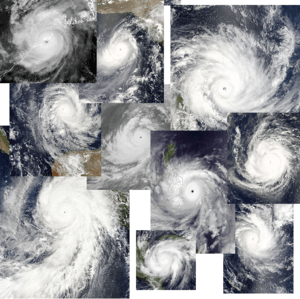
In the available records, a total of 78 tropical cyclones attained a pressure of 900 hPa (mbar) (26.56 inHg) or less, most of which occurred in the Western North Pacific Ocean. The strongest tropical cyclone recorded worldwide, as measured by minimum central pressure, was Typhoon Tip, which reached a pressure of 870 hPa (25.69 inHg) on October 12, 1979.[1] The following list is subdivided by basins. Data listed are provided by the official Regional Specialized Meteorological Centre, unless otherwise noted. On October 23, 2015, Hurricane Patricia attained the strongest 1-minute sustained winds on record at 215 mph (345 km/h).[2]
North Atlantic Ocean
The most intense storm in the North Atlantic by lowest pressure was Hurricane Wilma The strongest storm by 1-minute sustained winds was Hurricane Allen.
Storm with an intensity of 925 hPa (27.32 inHg) or less are listed.
| Cyclone | Season | Peak 1-min sustained winds | Pressure | ||
|---|---|---|---|---|---|
| "Cuba" | 1924 | 270 km/h (165 mph) | 910 hPa (26.87 inHg) | ||
| "Cuba" | 1932 | 280 km/h (175 mph) | 915 hPa (27.02 inHg) | ||
| "Labor Day" | 1935 | 295 km/h (185 mph) | 892 hPa (26.34 inHg) | ||
| Janet | 1955 | 280 km/h (175 mph) | 914 hPa (26.99 inHg) | ||
| Hattie | 1961 | 260 km/h (160 mph) | 920 hPa (27.17 inHg) | ||
| Camille | 1969 | 280 km/h (175 mph) | 900 hPa (26.58 inHg) | ||
| David | 1979 | 280 km/h (175 mph) | 924 hPa (27.29 inHg) | ||
| Allen | 1980 | 305 km/h (190 mph) | 899 hPa (26.55 inHg) | ||
| Gloria | 1985 | 230 km/h (145 mph) | 919 hPa (27.14 inHg) | ||
| Gilbert | 1988 | 295 km/h (185 mph) | 888 hPa (26.22 inHg) | ||
| Hugo | 1989 | 260 km/h (160 mph) | 918 hPa (27.11 inHg) | ||
| Andrew | 1992 | 280 km/h (175 mph) | 922 hPa (27.23 inHg) | ||
| Opal | 1995 | 240 km/h (150 mph) | 916 hPa (27.05 inHg) | ||
| Mitch | 1998 | 285 km/h (180 mph) | 905 hPa (26.72 inHg) | ||
| Floyd | 1999 | 250 km/h (155 mph) | 921 hPa (27.20 inHg) | ||
| Isabel | 2003 | 270 km/h (165 mph) | 915 hPa (27.02 inHg) | ||
| Ivan | 2004 | 275 km/h (170 mph) | 910 hPa (26.87 inHg) | ||
| Katrina | 2005 | 280 km/h (175 mph) | 902 hPa (26.64 inHg) | ||
| Rita | 2005 | 285 km/h (180 mph) | 895 hPa (26.43 inHg) | ||
| Wilma | 2005 | 295 km/h (185 mph) | 882 hPa (26.05 inHg) | ||
| Dean | 2007 | 280 km/h (175 mph) | 905 hPa (26.72 inHg) | ||
| Igor | 2010 | 250 km/h (155 mph) | 924 hPa (27.29 inHg) | ||
| Source: Atlantic Hurricane Best Track File 1851–2015 [3] | |||||
Eastern Pacific Ocean
Storms with an intensity of 922 hPa (27.23 inHg) or less are listed.
| Cyclone | Season | Peak 1-min sustained winds | Pressure | |
|---|---|---|---|---|
| Ava | 1973 | 260 km/h (160 mph) | 915 hPa (27.02 inHg) | |
| Gilma | 1994 | 260 km/h (160 mph) | 920 hPa (27.17 inHg) | |
| Guillermo | 1997 | 260 km/h (160 mph) | 919 hPa (27.14 inHg) | |
| Linda | 1997 | 295 km/h (185 mph) | 902 hPa (26.64 inHg) | |
| Elida | 2002 | 260 km/h (160 mph) | 921 hPa (27.20 inHg) | |
| Hernan | 2002 | 260 km/h (160 mph) | 921 hPa (27.20 inHg) | |
| Kenna | 2002 | 270 km/h (165 mph) | 913 hPa (26.96 inHg) | |
| Ioke | 2006 | 260 km/h (160 mph) | 915 hPa (27.02 inHg) | |
| Rick | 2009 | 285 km/h (180 mph) | 906 hPa (26.75 inHg) | |
| Celia | 2010 | 260 km/h (160 mph) | 921 hPa (27.20 inHg) | |
| Marie | 2014 | 260 km/h (160 mph) | 918 hPa (27.11 inHg) | |
| Odile | 2014 | 220 km/h (140 mph) | 918 hPa (27.11 inHg) | |
| Patricia | 2015 | 345 km/h (215 mph) | 872 hPa (25.75 inHg) | |
| Source: East Pacific Hurricane Best Track File 1851–2015 [4] | ||||
Western North Pacific Ocean

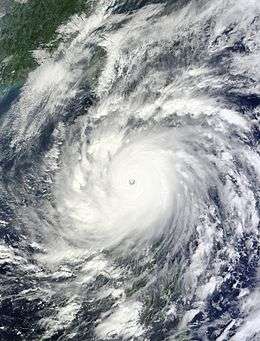

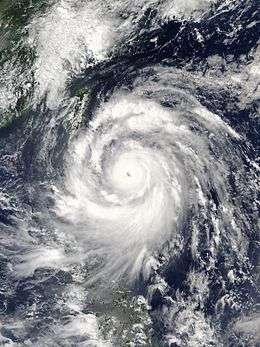
The most intense storm by lowest pressure and peak 10-minute sustained winds was Typhoon Tip, which was also the most intense tropical cyclone ever recorded.
Storms with a minimum pressure below 900 hPa (26.58 inHg) are listed.
| Cyclone | Year | Peak 10-min sustained winds | Pressure | |
|---|---|---|---|---|
| Clara | 1950 | Not Specified | 899 hPa (26.55 inHg) | |
| Marge | 1951 | Not Specified | 886 hPa (26.16 inHg) | |
| Nina | 1953 | Not Specified | 885 hPa (26.13 inHg) | |
| Tess | 1953 | Not Specified | 900 hPa (26.58 inHg) | |
| Ida | 1954 | Not Specified | 890 hPa (26.28 inHg) | |
| Pamela | 1954 | Not Specified | 900 hPa (26.58 inHg) | |
| Virginia | 1957 | Not Specified | 900 hPa (26.58 inHg) | |
| Lola | 1957 | Not Specified | 900 hPa (26.58 inHg) | |
| Ida | 1958 | Not Specified | 877 hPa (25.90 inHg) | |
| Vera | 1959 | Not Specified | 895 hPa (26.43 inHg) | |
| Joan | 1959 | Not Specified | 885 hPa (26.13 inHg) | |
| Nancy | 1961 | Not Specified | 882 hPa (26.05 inHg) | |
| Violet | 1961 | Not Specified | 895 hPa (26.43 inHg) | |
| Opal | 1962 | Not Specified | 900 hPa (26.58 inHg) | |
| Emma | 1962 | Not Specified | 890 hPa (26.28 inHg) | |
| Karen | 1962 | Not Specified | 894 hPa (26.40 inHg) | |
| Sally | 1964 | Not Specified | 895 hPa (26.43 inHg) | |
| Wilda | 1964 | Not Specified | 895 hPa (26.43 inHg) | |
| Opal | 1964 | Not Specified | 900 hPa (26.58 inHg) | |
| Bess | 1965 | Not Specified | 900 hPa (26.58 inHg) | |
| Kit | 1966 | Not Specified | 880 hPa (25.99 inHg) | |
| Carla | 1967 | Not Specified | 900 hPa (26.58 inHg) | |
| Agnes | 1968 | Not Specified | 900 hPa (26.58 inHg) | |
| Elsie | 1969 | Not Specified | 895 hPa (26.43 inHg) | |
| Viola | 1969 | Not Specified | 900 hPa (26.58 inHg) | |
| Hope | 1970 | Not Specified | 900 hPa (26.58 inHg) | |
| Amy | 1971 | Not Specified | 890 hPa (26.28 inHg) | |
| Nadine | 1971 | Not Specified | 900 hPa (26.58 inHg) | |
| Irma | 1971 | Not Specified | 885 hPa (26.13 inHg) | |
| Patsy | 1973 | Not Specified | 895 hPa (26.43 inHg) | |
| Nora | 1973 | Not Specified | 875 hPa (25.84 inHg) | |
| Nina | 1975 | Not Specified | 900 hPa (26.58 inHg) | |
| Elsie | 1975 | Not Specified | 900 hPa (26.58 inHg) | |
| June | 1975 | Not Specified | 875 hPa (25.84 inHg) | |
| Louise | 1976 | Not Specified | 895 hPa (26.43 inHg) | |
| Rita | 1978 | 220 km/h (140 mph) | 880 hPa (25.99 inHg) | |
| Hope | 1979 | 205 km/h (125 mph) | 900 hPa (26.58 inHg) | |
| Tip | 1979 | 260 km/h (160 mph) | 870 hPa (25.69 inHg) | |
| Wynne | 1980 | 220 km/h (140 mph) | 890 hPa (26.28 inHg) | |
| Elsie | 1981 | 220 km/h (140 mph) | 895 hPa (26.43 inHg) | |
| Bess | 1982 | 230 km/h (143 mph) | 900 hPa (26.58 inHg) | |
| Mac | 1982 | 220 km/h (140 mph) | 895 hPa (26.43 inHg) | |
| Abby | 1983 | 220 km/h (140 mph) | 895 hPa (26.43 inHg) | |
| Forrest | 1983 | 205 km/h (125 mph) | 885 hPa (26.13 inHg) | |
| Marge | 1983 | 205 km/h (125 mph) | 895 hPa (26.43 inHg) | |
| Vanessa | 1984 | 220 km/h (140 mph) | 880 hPa (25.99 inHg) | |
| Dot | 1985 | 220 km/h (140 mph) | 895 hPa (26.43 inHg) | |
| Peggy | 1986 | 205 km/h (125 mph) | 900 hPa (26.58 inHg) | |
| Betty | 1987 | 205 km/h (125 mph) | 890 hPa (26.28 inHg) | |
| Holly | 1987 | 205 km/h (125 mph) | 900 hPa (26.58 inHg) | |
| Flo | 1990 | 220 km/h (140 mph) | 890 hPa (26.28 inHg) | |
| Ruth | 1991 | 215 km/h (130 mph) | 895 hPa (26.43 inHg) | |
| Yuri | 1991 | 220 km/h (140 mph) | 895 hPa (26.43 inHg) | |
| Gay | 1992 | 205 km/h (125 mph) | 900 hPa (26.58 inHg) | |
| Zeb | 1998 | 205 km/h (125 mph) | 900 hPa (26.58 inHg) | |
| Megi | 2010 | 230 km/h (145 mph) | 885 hPa (26.13 inHg) | |
| Sanba | 2012 | 205 km/h (125 mph) | 900 hPa (26.58 inHg) | |
| Haiyan | 2013 | 230 km/h (145 mph) | 895 hPa (26.43 inHg) | |
| Vongfong | 2014 | 215 km/h (130 mph) | 900 hPa (26.58 inHg) | |
| Soudelor | 2015 | 215 km/h (130 mph) | 900 hPa (26.58 inHg) | |
| Nepartak | 2016 | 205 km/h (125 mph) | 900 hPa (26.58 inHg) | |
| Meranti | 2016 | 220 km/h (140 mph) | 890 hPa (26.28 inHg) | |
| Haima | 2016 | 215 km/h (130 mph) | 900 hPa (26.58 inHg) | |
| Source:Typhoon information for the Western Pacific ocean.[5] | ||||
North Indian Ocean

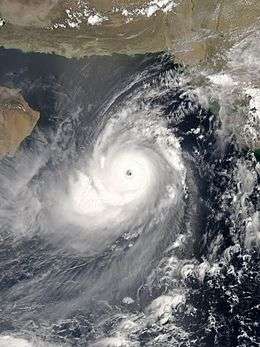
| Cyclone | Season | Peak 3-min sustained winds | Pressure | |
|---|---|---|---|---|
| Two | 1963 | 195 km/h (120 mph) | 947 hPa (27.96 inHg) | |
| Three | 1963 | 240 km/h (150 mph) | 920 hPa (27.17 inHg) | |
| 1977 Andhra Pradesh | 1977 | 205 km/h (125 mph) | 919 hPa (27.14 inHg) | |
| Gay | 1989 | 230 km/h (145 mph) | 930 hPa (27.46 inHg) | |
| 1990 Andhra Pradesh | 1990 | 230 km/h (145 mph) | 920 hPa (27.17 inHg) | |
| 1991 Bangladesh | 1991 | 240 km/h (150 mph) | 918 hPa (27.11 inHg) | |
| 1994 BOB 02 | 1994 | 215 km/h (135 mph) | 940 hPa (27.76 inHg) | |
| 1999 Pakistan | 1999 | 195 km/h (120 mph) | 946 hPa (27.94 inHg) | |
| "Paradip" | 1999 | 260 km/h (160 mph) | 912 hPa (26.93 inHg) | |
| 2001 India | 2001 | 215 km/h (135 mph) | 932 hPa (27.52 inHg) | |
| Gonu | 2007 | 240 km/h (150 mph) | 920 hPa (27.17 inHg) | |
| Sidr | 2007 | 215 km/h (135 mph) | 944 hPa (27.88 inHg) | |
| Giri | 2010 | 195 km/h (120 mph) | 950 hPa (28.05 inHg) | |
| Phailin | 2013 | 215 km/h (130 mph) | 940 hPa (27.76 inHg) | |
| Hudhud | 2014 | 185 km/h (115 mph) | 950 hPa (28.05 inHg) | |
| Nilofar | 2014 | 205 km/h (125 mph) | 950 hPa (28.05 inHg) | |
| Chapala | 2015 | 215 km/h (130 mph) | 940 hPa (27.76 inHg) | |
| Source: Tropical Cyclone Best Track Information for the North Indian Ocean 1851–2015[6] | ||||
South-West Indian Ocean
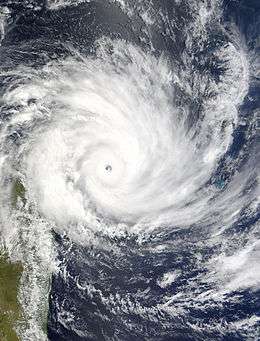
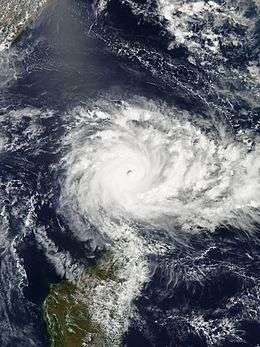
The most intense tropical cyclone in the South-West Indian Ocean is Cyclone Gafilo. By 10-minute sustained wind speed, the strongest tropical cyclone in the South-West Indian Ocean is Cyclone Fantala.
Storms with an intensity of 920 hPa (27.17 inHg) or less are listed.
| Cyclone | Season | Peak 10-min sustained winds | Pressure | |
|---|---|---|---|---|
| Chris-Damia | 1981–82 | 210 km/h (130 mph) | 898 hPa (26.52 inHg) | [7] |
| Geralda | 1993–94 | 200 km/h (125 mph) | 905 hPa (26.72 inHg) | [8] |
| Litanne | 1993–94 | 190 km/h (120 mph) | 910 hPa (26.87 inHg) | [8] |
| Marlene | 1994–95 | 180 km/h (110 mph) | 920 hPa (27.17 inHg) | [9] |
| Bonita | 1995–96 | 180 km/h (110 mph) | 920 hPa (27.17 inHg) | [10] |
| Daniella | 1996–97 | 190 km/h (120 mph) | 915 hPa (27.02 inHg) | [11] |
| Hudah | 1999–2000 | 220 km/h (135 mph) | 905 hPa (26.72 inHg) | [12] |
| Dina | 2001–02 | 215 km/h (135 mph) | 910 hPa (26.87 inHg) | [13] |
| Guillaume | 2001–02 | 205 km/h (125 mph) | 920 hPa (27.17 inHg) | [13] |
| Hary | 2001–02 | 220 km/h (135 mph) | 905 hPa (26.72 inHg) | [13] |
| Kalunde | 2002–03 | 215 km/h (135 mph) | 905 hPa (26.72 inHg) | |
| Gafilo | 2003–04 | 230 km/h (145 mph) | 895 hPa (26.43 inHg) | [14] |
| Adeline-Juliet | 2004–05 | 220 km/h (135 mph) | 905 hPa (26.72 inHg) | [15] |
| Bento | 2004–05 | 215 km/h (135 mph) | 915 hPa (27.02 inHg) | [16] |
| Carina | 2005–06 | 205 km/h (125 mph) | 915 hPa (27.02 inHg) | [17] |
| Hondo | 2007–08 | 215 km/h (135 mph) | 906 hPa (26.75 inHg) | [18] |
| Edzani | 2009–10 | 220 km/h (135 mph) | 910 hPa (26.87 inHg) | [19] |
| Bruce | 2013–14 | 230 km/h (145 mph) | 912 hPa (26.93 inHg) | |
| Hellen | 2013–14 | 230 km/h (145 mph) | 915 hPa (27.02 inHg) | |
| Bansi | 2014–15 | 220 km/h (135 mph) | 910 hPa (26.87 inHg) | |
| Eunice | 2014–15 | 230 km/h (145 mph) | 915 hPa (27.02 inHg) | |
| Fantala | 2015–16 | 250 km/h (155 mph) | 910 hPa (26.87 inHg) |
Australian Region
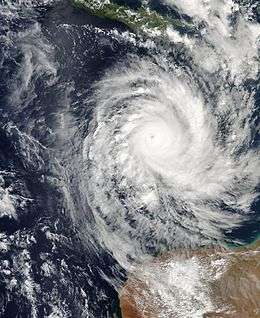
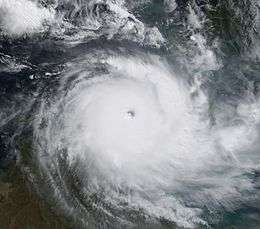
The most intense tropical cyclones in the Australian Region are Cyclone Gwenda and Cyclone Inigo. By 10-minute sustained wind speed, the strongest are Cyclone Orson and Cyclone Monica.
Storms with an intensity of 920 hPa (27.17 inHg) or less are listed.
| Cyclone | Season | Peak 10-min sustained winds | Pressure |
|---|---|---|---|
| Mahina | 1899 | 205 km/h (125 mph) | 914 hPa (26.99 inHg) |
| Joan | 1975–76 | 230 km/h (145 mph) | 915 hPa (27.02 inHg) |
| Amy | 1979–80 | 230 km/h (145 mph) | 915 hPa (27.02 inHg) |
| Orson | 1988–89 | 250 km/h (155 mph) | 904 hPa (26.70 inHg) |
| Graham | 1991–92 | 230 km/h (145 mph) | 915 hPa (27.02 inHg) |
| Theodore | 1993–94 | 200 km/h (125 mph) | 910 hPa (26.87 inHg) |
| Vance | 1998–99 | 215 km/h (135 mph) | 910 hPa (26.87 inHg) |
| Gwenda | 1998–99 | 220 km/h (140 mph) | 900 hPa (26.58 inHg) |
| Inigo | 2002–03 | 240 km/h (150 mph) | 900 hPa (26.58 inHg) |
| Fay | 2003–04 | 215 km/h (130 mph) | 910 hPa (26.87 inHg) |
| Floyd | 2005–06 | 195 km/h (120 mph) | 916 hPa (27.05 inHg) |
| Glenda | 2005–06 | 205 km/h (125 mph) | 910 hPa (26.87 inHg) |
| Monica | 2005–06 | 250 km/h (155 mph) | 916 hPa (27.05 inHg) |
| George | 2006–07 | 205 km/h (125 mph) | 902 hPa (26.64 inHg) |
South Pacific Ocean
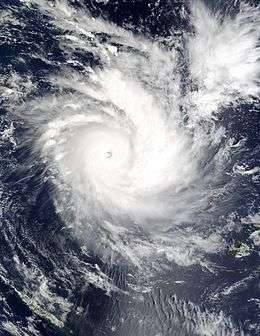
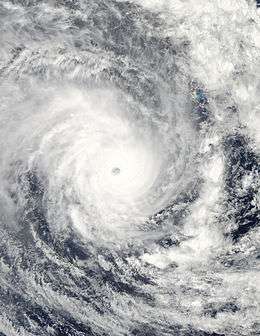
Storms with an intensity of 920 hPa (27.17 inHg) or less are listed. A total of 16 cyclones are listed down below reaching/surpassing that intensity, which most of them occurred during El Niño seasons. Tropical cyclones that have been recorded since the start of the 1969–70 Tropical Cyclone year and have reached their peak intensity to the west of 160E are included in the list. The most intense tropical cyclone in the south Pacific, Cyclone Zoe of 2002, is also the most intense storm in the Southern Hemisphere. By 10-minute sustained wind speed, the strongest tropical cyclone in the south Pacific is Cyclone Pam.
| Cyclone | Season | Peak 10-min sustained winds | Pressure |
|---|---|---|---|
| Oscar | 1982–83 | 205 km/h (125 mph) | 920 hPa (27.17 inHg) |
| Hina | 1984–85 | 220 km/h (135 mph) | 910 hPa (26.87 inHg) |
| Fran | 1991–92 | 205 km/h (125 mph) | 920 hPa (27.17 inHg) |
| Ron | 1997–98 | 230 km/h (145 mph) | 900 hPa (26.58 inHg) |
| Susan | 1997–98 | 230 km/h (145 mph) | 900 hPa (26.58 inHg) |
| Beni | 2002–03 | 205 km/h (125 mph) | 920 hPa (27.17 inHg) |
| Dovi | 2002–03 | 205 km/h (125 mph) | 920 hPa (27.17 inHg) |
| Erica | 2002–03 | 215 km/h (130 mph) | 915 hPa (27.02 inHg) |
| Zoe | 2002–03 | 240 km/h (150 mph) | 890 hPa (26.28 inHg) |
| Heta | 2003–04 | 215 km/h (130 mph) | 915 hPa (27.02 inHg) |
| Meena | 2004–05 | 215 km/h (130 mph) | 915 hPa (27.02 inHg) |
| Olaf | 2004–05 | 215 km/h (130 mph) | 915 hPa (27.02 inHg) |
| Percy | 2004–05 | 230 km/h (145 mph) | 900 hPa (26.58 inHg) |
| Ului | 2009–10 | 215 km/h (130 mph) | 915 hPa (27.02 inHg) |
| Pam | 2014–15 | 250 km/h (155 mph) | 896 hPa (26.46 inHg) |
| Winston | 2015–16 | 230 km/h (145 mph) | 915 hPa (27.02 inHg) |
| Sources:[20] | |||
South Atlantic Ocean
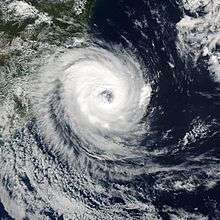
Due to the fact that tropical cyclones in the South Atlantic are rare, there is no official tropical cyclone season for this region. Despite this, there have been several significant tropical cyclones in the South Atlantic region, notably Hurricane Catarina in March 2004. Tropical and subtropical cyclones with an intensity of below 1000 hPa (29.53 inHg) are listed.
| Cyclone | Season | Peak 1-min sustained winds | Pressure |
|---|---|---|---|
| 1974 South Atlantic | 1974 | 45 km/h (30 mph) | 988 hPa (29.18 inHg) |
| Catarina | 2004 | 155 km/h (100 mph) | 972 hPa (28.70 inHg) |
| Anita | 2010 | 85 km/h (50 mph) | 995 hPa (29.38 inHg) |
| Arani | 2011 | 85 km/h (50 mph) | 989 hPa (29.21 inHg) |
| Bapo | 2015 | 65 km/h (40 mph) | 992 hPa (29.29 inHg) |
| Cari | 2015 | 65 km/h (40 mph) | 998 hPa (29.47 inHg) |
| Deni | 2016 | 75 km/h (45 mph) |
998 hPa (29.47 inHg) |
| Sources:[21] | |||
See also
- Atlantic hurricane season
- Pacific hurricane season
- Pacific typhoon season
- North Indian Ocean tropical cyclone season
- South-West Indian Ocean tropical cyclone season
- Australian region tropical cyclone season
- South Pacific tropical cyclone season
- South Atlantic tropical cyclone
References
- ↑ Dunnavan, George M; Diercks, John W (November 1, 1980). "An Analysis of Super Typhoon Tip (October 1979)". Monthly Weather Review. 108 (11): 1915–1923. Bibcode:1980MWRv..108.1915D. doi:10.1175/1520-0493(1980)108<1915:AAOSTT>2.0.CO;2. Retrieved February 24, 2013.
- ↑ Patricia, the strongest hurricane ever recorded, makes landfall in Mexico. http://www.cnn.com/2015/10/23/americas/hurricane-patricia/
- ↑ National Hurricane Center; Hurricane Research Division (July 6, 2016). "Atlantic hurricane best track (HURDAT version 2)". United States National Oceanic and Atmospheric Administration. Retrieved December 5, 2016.
- ↑ National Hurricane Center; Hurricane Research Division; Central Pacific Hurricane Center. "The Northeast and North Central Pacific hurricane database 1949–2015". United States National Oceanic and Atmospheric Administration's National Weather Service. A guide on how to read the database is available here.
- ↑ "Western North Pacific Typhoon best track file 1951–2016". Japan Meteorological Agency. 2010-01-13. Retrieved 2010-01-13.
- ↑ Regional Specialised Meteorological Centre (RSMC) - Tropical Cyclones, New Delhi. "IMD Best track data 1990-2015". India Meteorological Department. A guide on how to read the database is available here.
- ↑ "Cyclone Damia Best track". Météo-France. 2001-05-16. Retrieved 2010-01-08.
- 1 2 La Reunion Tropical Cyclone Centre. Cyclone Season 1993–1994 in the South-West Indian Ocean (in English and French). Météo France. pp. 42, 65. Retrieved December 22, 2013.
- ↑ La Reunion Tropical Cyclone Centre. Cyclone Season 1994–1995 in the South-West Indian Ocean (in English and French). Météo France. p. 67. Retrieved December 22, 2013.
- ↑ La Reunion Tropical Cyclone Centre. Cyclone Season 1995–1996 in the South-West Indian Ocean (in English and French). Météo France. pp. 25,. Retrieved December 22, 2013.
- ↑ La Reunion Tropical Cyclone Centre. Cyclone Season 1996–1997 in the South-West Indian Ocean (in English and French). Météo France. p. 33. Retrieved December 22, 2013.
- ↑ La Reunion Tropical Cyclone Centre. Cyclone Season 1999–2000 in the South-West Indian Ocean (in English and French). Météo France. p. 72. ISBN 2-9511665-3-2. Retrieved December 22, 2013.
- 1 2 3 La Reunion Tropical Cyclone Centre. Cyclone Season 2001–2002 in the South-West Indian Ocean (in English and French). Météo France. p. 4. ISBN 2-9511665-6-7. Retrieved December 22, 2013.
- ↑ La Reunion Tropical Cyclone Centre. Cyclone Season 2003–2004 in the South-West Indian Ocean (in English and French). Météo France. p. 67. ISBN 2-9511665-8-3. Retrieved December 22, 2013.
- ↑ La Reunion Tropical Cyclone Centre (November 27, 2009). "Very Intense Tropical Cyclone Adeline-Juliet". Météo France. Retrieved December 22, 2013.
- ↑ La Reunion Tropical Cyclone Centre (November 27, 2009). "Intense Tropical Cyclone Bento". Météo France. Retrieved December 22, 2013.
- ↑ La Reunion Tropical Cyclone Centre. South-West Indian Ocean Cyclone Season 2005–2006 (in English and French). Météo France. p. 6. ISBN 2-9511665-9-1. Retrieved December 22, 2013.
- ↑ La Reunion Tropical Cyclone Centre (November 27, 2009). "Very Intense Tropical Cyclone Hondo". Météo France. Retrieved December 22, 2013.
- ↑ La Reunion Tropical Cyclone Centre (August 31, 2010). "Very Intense Tropical Cyclone Edzani". Météo France. Retrieved December 22, 2013.
- ↑ MetService (May 22, 2009). "TCWC Wellington Best Track Data 1967–2006". International Best Track Archive for Climate Stewardship.
- ↑ "Second only south Atlantic tropical storm: 90Q, moving away from Brazil". Retrieved 2011-06-23.
External links
- US National Hurricane Center – North Atlantic, Eastern Pacific
- Central Pacific Hurricane Center – Central Pacific
- Japan Meteorological Agency – North West Pacific
- India Meteorological Department – North Indian Ocean
- Météo-France – La Reunion – South-West Indian Ocean from 30°E to 90°E
- Fiji Meteorological Service – South Pacific west of 160°E, north of 25° S
- Indonesian Meteorological Department – South Indian Ocean from 90°E to 125°E, north of 10°S
- Australian Bureau of Meteorology (TCWC's Perth, Darwin & Brisbane). – South Indian Ocean & South Pacific Ocean from 90°E to 160°E, south of 10°S
- Meteorological Service of New Zealand Limited – South Pacific west of 160°E, south of 25°S
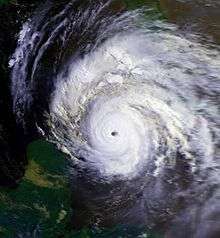
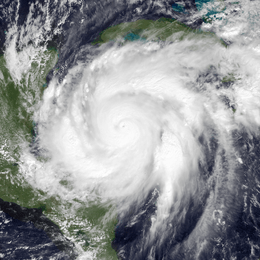

.jpg)